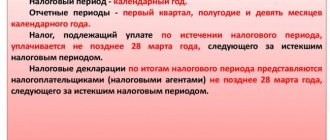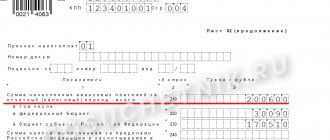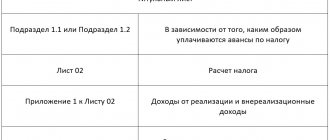Basic version of income taxation and deviations from it
Clause 1 of Art. 284 of the Tax Code of the Russian Federation established the basic rate of income tax in 2021. in the amount of 20%. In the basic version, it is distributed between budgets as follows:
- Russian budget – 2%;
- regional budgets – 18%.
However, from 2021 to 2021, a different order is in force, according to which the federal budget receives 3%, and regional ones - 17%
This deviation is established by the law of November 30, 2016 No. 401-FZ “On Amendments...”.
Also 20% tax is charged:
- From organizations producing hydrocarbons in a new offshore field.
- From controlling persons on the profits of controlled foreign companies.
For the last two categories, distribution between budgets does not apply; all 20% of the tax is credited to the federal budget.
Subjects of the Russian Federation have the right to lower rates for crediting to their budgets for certain categories of taxpayers. In general, the “regional” rate can be reduced to 13.5% (in 2017-2020 - to 12.5%), and for residents of special economic zones - to lower values.
In addition, reduced “regional” rates (from 0% to 10%) are applied to organizations participating in regional investment projects (clause 3 of article 284.3 and clause 3 of article 284.3-1 of the Tax Code of the Russian Federation).
Sample of filling out a payment slip for income tax credited to the federal budget in 2021. can be downloaded here.
Other filling options will differ in the purpose of payment (type of budget) and BCC.
What is the income tax rate in 2021
This year, the previous rate of this tax remains at 20 percent. The only thing that has changed is the proportion by which money is distributed between budgets. If previously the regional budget received 18 percent, and 2 percent went to the federal treasury, now the center wanted more money. In 2021, 17 percent remains in the region, and 3 percent goes to Moscow.
These proportions will exist until the end of 2021.
Taxation of dividend income
Income tax for 2021 in the form of dividends is assessed in accordance with clause 3 of Art. 284 Tax Code of the Russian Federation:
- For Russian organizations - 13% of income received both from residents of the Russian Federation and from foreign companies, as well as income from shares, the rights to which are certified by depositary receipts.
- For foreign companies – 15% of income received from participation in the capital of Russian organizations.
If a Russian organization owned more than 50% of the authorized capital of the paying company during the year before paying dividends, then income on them is taxed at a rate of 0%. If the payer of dividends is a non-resident company, then it should not be included in the so-called. “black list” of offshore companies (order of the Ministry of Finance of the Russian Federation dated November 13, 2007 No. 108n).
Moment of recognition of income and expenses
The moment of recognition is the period of time in which income or expenses are reflected in income tax accounting. There are two such moments. They depend on the method of recognizing income and expenses:
- cash method;
- accrual method.
The company chooses one of the methods, and before December 31 (without waiting for the start of the next tax period) informs the territorial body of the Federal Tax Service of Russia about its choice.
When applying methods, firms take into account amounts at different points in time. Let's look into the nuances.
The cash method assumes that:
- income is taken into account at the time of receipt at the cash desk or in the company's current account, not earlier;
- expenses are taken into account at the time of debiting from the account or paying from the cash register, not earlier;
- When paying tax, amounts are taken into account according to the dates of receipt or write-off.
- income is taken into account at the time of occurrence (under contracts or payment orders), and not upon direct payment;
- expenses are taken into account at the time of occurrence, and not when funds are written off from accounts;
- When paying tax, amounts are taken into account based on documented dates, even if payment actually occurred later.
Kolibri LLC issued an invoice for office rent in March, but payment was made only in June. Under the cash method, the accountant of Kolibri LLC reflects the expenses for renting an office in June - upon the transfer of money. In tax accounting, this expense is written off in the 2nd quarter. Under the accrual method, the accountant of Kolibri LLC takes into account rental expenses in March, when the company should have paid it. In tax accounting, this expense is reflected in the first quarter.
All enterprises can use the accrual method. But the use of the cash method is limited:
- Banks are prohibited from using it;
- Firms recognize income and expenses in fact only if revenue does not exceed 1 million rubles. for each of the last four quarters;
- If, when applying the method, the limit is exceeded, then the company is obliged to switch to the accrual method from the beginning of the current year.
What is the tax base if the company suffers a loss?
According to tax accounting rules, the profit of an organization cannot be negative. Even if there is a loss at the end of the year, the tax base is recognized as zero. The tax in this case is also zero. Tax accounting registers must confirm the correctness of the tax base calculation. It is mandatory to submit a declaration, even if the amount is zero.
- recommendations and assistance in resolving issues
- regulations
- forms and examples of filling them out
Read more: How to register a child from a surrogate mother
Taxation of income from debt obligations
Income tax for 2021 on debt obligations is calculated in accordance with clause 4 of Art. 284 Tax Code of the Russian Federation:
- In the amount of 15% for income on the following types of securities:
– government securities of member countries of the Union State, constituent entities of the Russian Federation and municipal securities;
– mortgage-backed bonds issued after January 1, 2007;
– bonds of Russian resident companies issued in the period 2017-2021. and traded on the organized market
– income received from trust management of mortgage coverage, if the relevant certificates were issued after January 1, 2007.
- The rate of 9% is valid for the following types of securities:
– municipal securities issued before January 1, 2007. for a period of more than 3 years;
– mortgage-backed bonds issued before January 1, 2007;
– income received from trust management of mortgage coverage, if the certificates were issued before January 1, 2007.
- Income from the following debt obligations is taxed at a 0% rate:
– state and municipal bonds issued before January 20, 1997.
– government foreign currency loan bonds of 1999, issued to ensure the conditions for settling the foreign currency debt of the former USSR and the Russian Federation.
- An increased rate of 30% is applied to income from securities of Russian organizations recorded in securities accounts of foreign holders, if information about them was not provided to the tax agent (clause 4.2 of Article 284 of the Tax Code of the Russian Federation).
Calculation example
Let's give an example of how to calculate income tax.
During the year, the company received an income of 3 million rubles. Her expenses during the same time amounted to 1,100,000 rubles. That is, the company’s profit for the year amounted to 1,900,000 rubles. Tax will be paid on this amount.
1900000 * 20% = 380000 rubles. The company will pay this amount as income tax.
Similar articles
- Income tax in Russia
- How to calculate income tax: example
- Income tax in 2021 - rate
- Elements of income tax
- How to calculate income tax
Taxation of income of foreign companies
If a non-resident company operates in the Russian Federation through a permanent representative office, then its profits are taxed on a general basis, similar to Russian organizations
If there is no representative office, then tax is levied depending on the type of income:
- In the amount of 10% - on income from the use or rental of vehicles for international transport.
- In the amount of 20% - for all other income of a foreign company, except dividends and income on debt obligations.
All tax amounts on dividends, debt obligations and income of non-residents who do not have a permanent establishment are credited to the federal budget (clause 6 of Article 284 of the Tax Code of the Russian Federation).
How to calculate income tax for organizations in 2021 using a calculator
To simplify calculations, you can use the calculator located on the website ppt.ru.
First, select the income tax amount (as a percentage).
In the “Income” field, enter the amount earned during the year.
In the “Expenses” field, enter the amount of all expenses including VAT.
- total profit excluding VAT;
- total amount of loss excluding VAT;
- VAT payable;
- tax amount;
- profit remaining for business development.
The 1C:BusinessStart service for entrepreneurs will tell you how to calculate income tax in 2021 automatically and more.
According to the general rule, organizations applying the general taxation regime must calculate income tax based on the results of reporting periods, as well as based on the results of the year (clause 2 of Article 286 of the Tax Code of the Russian Federation).
“Zero” income tax benefit
For certain categories of legal entities or types of income, there is a preferential income tax rate for 2021, namely 0%. Some cases of its application (for dividends and debt obligations) were discussed above.
In addition to them, the “zero” benefit applies in the following cases:
- For educational and medical organizations (Article 284.1 of the Tax Code of the Russian Federation).
- For residents of tourist and recreational economic zones united in a cluster - in terms of the tax credited to the federal budget.
- For agricultural and fisheries producers in terms of their agricultural products and their processed products.
- For participants in regional investment projects (clause 2 of Article 284.3, clause 2 of Article 284.3-1 of the Tax Code of the Russian Federation), participants in the free economic zone, residents of the priority development territory and the free port of Vladivostok (Article 284.4 of the Tax Code of the Russian Federation). For all categories listed in this paragraph, the benefit applies only to the “federal” part of the tax.
- For organizations providing social services to citizens (Article 284.5 of the Tax Code of the Russian Federation).
- For the Central Bank of the Russian Federation.
- For participants of the Skolkovo project after the termination of the use of the right to exemption and before exceeding the established limit (clause 2 of Article 246 of the Tax Code of the Russian Federation and clause 5.1 of Article 284 of the Tax Code of the Russian Federation).
- For income from operations from the sale or other disposal of participation interests in the authorized capital of Russian companies (clause 4.1 of Article 284 of the Tax Code of the Russian Federation).
Sheet 02 Calculation of income tax and advance payments
For 2021, changes are being made to Art. 286 of the Tax Code of the Russian Federation (Federal Law of April 22, 2020 N 121-FZ):
- The revenue limit for payment of quarterly payments is increased from 15 to 25 million rubles. quarterly;
- Taxpayers who pay monthly advance payments based on estimated profits can switch to paying monthly advance payments based on actual profits before the end of 2021, starting from the January-April reporting period.
Organizations affected by coronavirus are exempt from advance payments of income tax in terms of payments for the second quarter of 2021 (Federal Law of 06/08/2020 N 172-FZ).
Read more Cancellation of taxes for the 2nd quarter of 2021 for affected industries
Let's look at the step-by-step filling out of the Sheet 02 declaration regarding the calculation of income tax for the first half of the year and the amount of monthly advance payments for the third quarter.
Step 1. Determine the amount of income tax for the first half of the year (pages 180-200)
The amount of income tax in 1C is calculated automatically based on the tax base indicated on page 120 and the rate on page 140 (150-170).
Check the calculation for the first half of the year using the formula:
In our example, the total amount of income tax (page 180) is 2,800,000 x 20% = 560,000 rubles, including:
- to the federal budget (p. 190) - 2,800,000 x 3% = 84,000 rubles;
- to the budget of a constituent entity of the Russian Federation (page 200) - 2,800,000 x 17% = 476,000 rubles.
Step 2. Enter the amount of advance payments calculated for the previous period (pages 210-230)
Advance payments that the organization must pay for the period of the first half of the year must be indicated on page 210 (220, 230) in 1C manually, since they are calculated according to the declaration for the first quarter of the current year and consist of:
- tax calculated based on the results of the first quarter (pages 180, 190, 200);
- accrued advance payments payable in the second quarter (lines 290, 300, 310);
- trade tax paid in the first quarter, by which the profit tax for the first quarter was reduced (p. 267).
In lines 220, 230 in the declaration for the first half of the year, manually enter the amounts calculated using the formula:
In our example, the amount of accrued advance payments for the first half of the year is:
- federal budget (p. 220) - 30,000 rubles. + 30,000 rub. = 60,000 rub.;
- budget of a constituent entity of the Russian Federation (p. 230) - 170,000 rubles. + 170,000 – 30,000 rub. = 310,000 rub.
The calculated amounts are indicated on page 210 (220,230) of the declaration for the first half of the year.
Step 3: Check the amount of trade fee paid (pages 265, 266, 267)
Lines 265, 266, 267 of Sheet 02 of the declaration in 1C are filled out automatically if the organization has registered a retail outlet in the program and automatically calculates the trade fee.
In the declaration for the first half of the year, these lines are filled in as follows:
- p. 265 – the amount of trade tax actually paid to the budget of a constituent entity of the Russian Federation since the beginning of the year. In our example, the amount is 60,000 rubles.
In 1C, in line 265, the turnover according to Kt 68.13 is automatically filled in ( Type of payment - Tax accrued/paid ). In our opinion, this is not an entirely correct algorithm for filling out the line, since the amount accrued may not always coincide with the amount paid, i.e. with the turnover Dt 68.13 Kt. Therefore, pay attention and check the completion of this line. If necessary, refill it manually.
Another feature of the program : line 265 will not be automatically filled in if there is a credit balance in account 68.13 “Trade fee” on the date of signing the income tax return.
- line 266 – the amount of the trading fee by which the profit tax was reduced in previous reporting periods of the current year. This line should be equal to the amount on page 267 in the declaration for the first quarter.
In 1C, in the half-year declaration, line 266 automatically fills in the amount of the reduction in income tax on the trading fee for the first quarter, i.e. this is the turnover:
- Dt 68.04.1 ( Budget level - Regional budget , Type of payment - Tax accrued/paid ).
- Kt 68.13 ( Type of payment - Tax accrued/paid ).
In our example, page 266 is equal to 30,000 rubles.
- p. 267 – the amount of the trade fee, which reduces the calculated income tax for the first half of the year to the republican budget. The line indicator cannot be greater than the amount on page 200 “Amount of accrued tax to the budget of a constituent entity of the Russian Federation.”
Find out in detail about the features of reducing income tax by the amount of trade tax
In 1C, line 267 automatically fills in the amount of the reduction in income tax on the trading fee for the first half of the year, i.e. this is the turnover:
- Dt 68.04.1 ( Budget level - Regional budget, type of payment - Tax accrued/paid ).
- Kt 68.13 ( Type of payment - Tax accrued/paid ).
In our example, page 267 is equal to 60,000 rubles.
Read more about the Trade Fee
Step 4. Determine the amount of tax to be paid additionally (pages 270, 271) or reduced (pages 280, 281)
Now determine which is bigger:
- actual tax amounts calculated based on the results of the first half of the year (pages 190, 200);
- the amounts of accrued advance payments that the taxpayer was obliged to pay in this period (pages 220, 230) taking into account the trade tax (page 267), calculated based on the results of the declaration for the first quarter.
Step 4.1. Federal budget
If line 190 is greater than line 220 , then the tax to the federal budget for the first half of the year must be paid in addition, i.e. in 1C line 270 will be automatically filled in according to the formula:
If line 190 is less than line 220 , then the tax to the federal budget at the end of the first half of the year will be reduced, i.e. in 1C line 280 will be automatically filled in according to the formula:
In our example, line 190 (amount of 84,000 rubles) is greater than line 220 (amount of 60,000 rubles), therefore, the tax to the federal budget for the first half of the year will be additionally paid:
- page 270 = 84,000 - 60,000 = 24,000 rub.
Step 4.2. Budget of a constituent entity of the Russian Federation
If line 200 is greater than the amount (line 230 + page 267) , then the tax to the budget of the constituent entity of the Russian Federation for the first half of the year must be paid additionally, i.e. in 1C line 271 will be automatically filled in according to the formula:
If line 200 is less than the amount (line 230 + line 267) , then the tax to the budget of the constituent entity of the Russian Federation at the end of the first half of the year will be reduced, i.e. in 1C line 281 will be automatically filled in according to the formula:
In our example, line 200 (amount 476,000 rubles) is greater than the sum of lines 230 and 267 (370,000 = 310,000 + 60,000), therefore, the amount of tax to the budget of a constituent entity of the Russian Federation at the end of the first half of the year will be additionally paid:
- page 271 = 476,000 0 = 106,000 rub.
Step 5. Determine the amount of advance payments due in the third quarter (pages 290-310)
Organizations paying monthly advance payments must, based on the results of the first half of the year, calculate the advances payable in the third quarter. Such payments are reflected on line 290 (300, 310).
In 1C, these lines are filled in manually. Advance payments payable must be calculated using the formula:
If, as a result of the calculation on page 290 (300, 310), a zero or negative value is obtained, then this line NOT filled in, and in the third quarter, monthly advance payments are not paid (paragraph 6, clause 2, article 286 of the Tax Code of the Russian Federation).
In our example, the amount of monthly advance payments payable in the third quarter is calculated:
- total (page 290) - 560,000 rub. – 200,000 rub. = 360,000 rubles, including: to the federal budget (p. 300) = 84,000 rubles. – 30,000 rub. = 54,000 rub.;
- to the budget of a constituent entity of the Russian Federation (p. 310) = 476,000 rubles. – 170,000 rub. = 306,000 rub.





